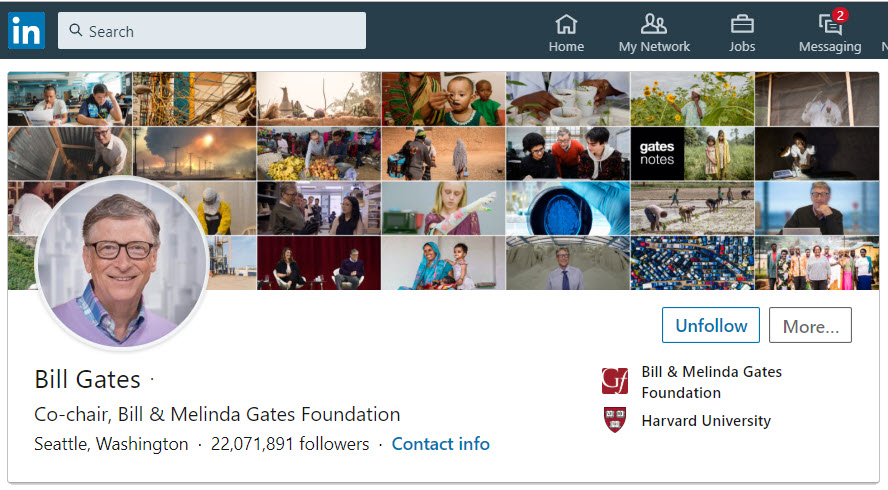
Before developing your plan as a CRO, CXO or business owner, or salesperson, it is important to reflect your best self and offer opportunities for others to see “social proof” to show you are who you say you are.
On the one hand, someone who believes they are a VIP and LinkedIn is beneath them may prefer to be invisible, with no information or photo. On the other hand, those who have a purpose and hope to influence others understand that a platform such as LinkedIn provides an opportunity to share their wealth of thoughts, make recommendations and lead.
Example: Bill Gates is not likely to use LinkedIn as a connection/communication tool, but he regularly posts activities and articles. Over 22 million people follow Bill Gates’s activities. It is true that while not every post will be viewed by his followers, they have said in public “Bill Gates is remarkable, I am interested in learning more and potentially share his posts.”

Today I will not go in depth to talk about social media strategy and how it relates to your role and generating profitable revenue. I do want to offer you a starting point and a question: “How will you move people to join you if you are invisible and it is more difficult to refer you or share your work?”
By developing your LinkedIn profile and making it accessible by others, you are opening new doors. If you prefer, as you set up your LinkedIn profile, you can turn off the option for people to contact you via LinkedIn. You can also turn off the notification settings from LinkedIn.
A simple planning guide
Here is a simple planning guide you can follow to create an individual summary paragraph at the top of your LinkedIn profile. This paragraph is one of the most important pieces of your profile. It should be used to highlight the things that are professionally important to you what you want to continue doing in the future.
In crafting this paragraph, first answer the following questions:
- As the [insert your title here] I focus on _____________.
- It’s important to me that ____________.
- These are the things that I enjoyed doing in my past jobs: _______________.
- In my current role I’m passionate about _____________________.
- I have achieved these results ______________________ in my role or past roles.
- In the future I plan to continue to ______________________.
It is not necessary to have every question answered. Pick a few of the answers from the fill-in-the-blanks above to use as the paragraph foundation.
Then consider - who is your target audience? Who are your prospective clients, potential collaborators or referral partners? It could be a long list, so I suggest that you pick the top two (maybe three if pushed) and write it as if you are talking to them.
The key to a successful summary paragraph is to make it personal, to let your voice show through.
It is also important to consider the length of this summary. It’s a balancing act – people won’t read a lot of text and yet if there are specific quantitative results that you want to include you should, with the appropriate formatting (bullet points, white space, etc.)
One last thing – your purpose in writing this summary is not to find a new job, as many on LinkedIn are doing. Instead this paragraph should let your selected audiences know more about who you are professionally. As you are a potential collaborator or partner, it should also give your audiences insight into why they should do business with you.
If you are a professional, here are my thoughts about what your profile summary might say at a very basic level:
As the “your role”, I am responsible for guiding the future success of our organization while overseeing the business day-to-day. It is important to me that our “clients, staff, resellers, consultants, collaborators” achieve their desired outcomes. For our staff and consultants, it means achieving a quality of life balance between work and play. For our clients, it is important that I provide the staff and support to meet their needs. The successes I have achieved in my years of experience as a “VP, COO, Director, Executive Manager” have prepared me to meet this challenge. I am passionate about helping our clients grow and succeed – it is what keeps them coming back and me engaged.
As you create and implement a revenue development action plan, what appear to be “little things” such as spinach in your teeth or a spot on your tie can become a barrier to moving forward. The absence of recommendations from others, a lack of activity that includes your perspectives or passions creates a gap. People will want to cheer, refer and do business with you… or work for you. Don’t leave them empty handed. Your profile is a step in the right direction.
Once you have your LinkedIn profile ready, the Revenue Development Action Plan can help your company achieve its B2B sales goals.
Get your copy of this plan now or contact Resultist for more information.

